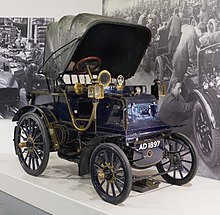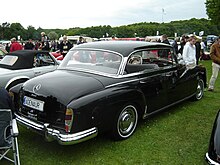
Back هيكل فيتون Arabic Phaeton (Karosseriebauform) German Faetón (carrocería) Spanish Phaeton (korimalli) Finnish Phaéton (automobile) French Faetón (carrozaría) Galician Ֆաետոն (թափք) Armenian Файтон INH Phaeton Italian フェートン (車両) Japanese



A phaeton is a style of open automobile without any fixed weather protection, which was popular from the 1900s until the 1930s. It is an automotive equivalent of the horse-drawn fast, lightweight phaeton carriage.[1]
A popular style in the US from the mid–1920s and continuing into the first half of the 1930s was the dual cowl phaeton, with a cowl separating the rear passengers from the driver and front passenger.[2]
Phaetons fell from favour when closed cars and convertible body styles became widely available during the 1930s. Eventually, the term "phaeton" became so widely and loosely applied that almost any vehicle with two axles and a row or rows of seats across the body could be called a phaeton.[3] Convertibles and pillarless hardtops were sometimes marketed as "phaetons" after actual phaetons were phased out.
- ^ "Definition of Phaeton". The Free Dictionary. Retrieved 17 December 2017.
- ^ Haajanen, Lennart W. (2017). Illustrated Dictionary of Automobile Body Styles (Second ed.). McFarland. p. 71. ISBN 978-1-4766-2404-4. Retrieved 17 December 2017.
- ^ Cite error: The named reference
Terrywas invoked but never defined (see the help page).